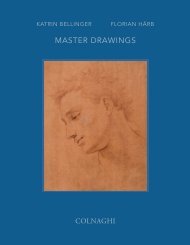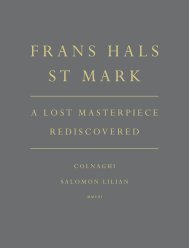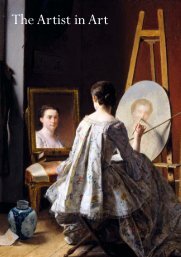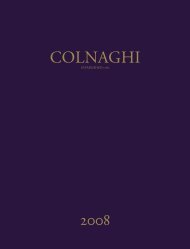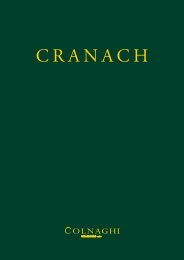2007 Catalogue - Colnaghi
2007 Catalogue - Colnaghi
2007 Catalogue - Colnaghi
Create successful ePaper yourself
Turn your PDF publications into a flip-book with our unique Google optimized e-Paper software.
Provenance: Provenance: Marchesi de Mari, Genoa,<br />
from whom traditionally believed to have been<br />
acquired by the great-grandmother of the present<br />
owner some time before 1884; thence by family<br />
descent to the previous owner.<br />
These two, exquisitely painted devotional pictures,<br />
unpublished but recently accepteded by Baldassari as<br />
autograph works, were painted in 1678 according to<br />
the date on the reverse of one of the stretchers. 1 The<br />
Madonna, and presumably its pendant the Christ<br />
Carrying the Cross, was conceived on 13th May 1678<br />
and the old handwriting on the reverse of the stretcher<br />
may well be Dolci’s own. The form of the date with<br />
interlocking initials - A[nno] S[alutatis] - may be<br />
compared to Dolci’s date and inscription on Patience,<br />
datable to the previous year. 2 The inscriptions on the<br />
reverse of the paintings may also be interpreted as<br />
prayers of redemption with invocations to Christ and<br />
the Madonna to intercede on the artist or patron’s<br />
behalf. This, together with their intimate scale, would<br />
suggest that the paintings were intended for private<br />
devotion. The pairing of Christ with the Madonna is<br />
by no means unique in Dolci’s œuvre: a very<br />
comparable small-scale ‘diptych’ showing Christ and<br />
the Madonna, also inscribed on the reverse and dating<br />
from three years later, 1681, is in the Statens Museum<br />
for Kunst, Copenhagen, though there the figure of<br />
Christ is shown with his eyes to Heaven rather than<br />
carrying the Cross and confronting the viewer. 3<br />
Both of the <strong>Colnaghi</strong> compositions exist in other<br />
versions within Dolci’s œuvre but no other variant was<br />
executed on such a small scale. The Christ carrying the<br />
cross is an almost exact replica of a larger work, dated<br />
by Baldassari to the second half of the 1660s in a<br />
private collection in Rome. 4 The <strong>Colnaghi</strong> Christ<br />
repeats its earlier prototype almost exactly, with the<br />
same choice of colours and an identical composition<br />
(the latter being equally suited to a rectangular and an<br />
14<br />
Carlo Dolci<br />
(Florence 1616 – 1687 Florence)<br />
Christ Carrying the Cross and Madonna<br />
Both inscribed on the reverse of the original stretcher in an old hand, possibly the artist's own, the first: IHS/ Amore/ et/ nostra/ redenzio/ Desiderium<br />
and the second AS/ 1678 à 13/ di maggio princi/ piata/ Satisma:/ Maria Ora/ pro nobis pechato/ ribus<br />
Oil on canvas, a pair<br />
12 3 /4 x 10 5 /8 in. (32.3 x 27 cm.)<br />
46<br />
octagonal-shaped canvas). The reddish highlights in<br />
Christ’s hair have been replicated exactly and Dolci has<br />
used gold paint not only for Christ’s halo in our work,<br />
but also for his hair, lashes and irises. However there<br />
are minor variations which give an added pathos to the<br />
<strong>Colnaghi</strong> version: Christ’s eyes have been brought<br />
slightly closer together and Dolci has delicately painted<br />
a teary edge along the lower lids, absent from the larger<br />
variant. In both versions Christ’s lips are parted, as if he<br />
is about speak, and the directness of his gaze underlines<br />
the pathos of the scene. Both versions are remarkable<br />
for the meticulousness with which the artist has<br />
painted the details of Christs’s hair and beard, the<br />
Crown of Thorns, and the grain of the wood of the<br />
Cross which heighten the emotional impact and<br />
spiritual intensity of the image.



